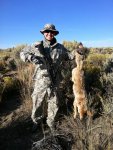I hear ya, CBM
Lots of guys who use e-callers just turn on the bunny blues, let 'em play constantly, and kill plenty of coyotes.
But, if you're hand calling, you'd prolly be better served with shorter series. Not because less calling is better, but for some of the reasons stated above. To reiterate:
Hand calling requires movement. The less movement on stand, the better.
Hand calling focuses the coyote's attention direclty TO your position. A coyote will burn the source of that sound down with its eyes, ASAP. Smart coyotes will only approach to where they've gained a vantage point of the sound source, and will come no further without visual confirmation. If they do, it will be the dreaded downwind circle to get confirmation with their nose! If you are not set up for that, you are busted...
Calling less will make them come "hunting" for the source, don't give it to them on a silver platter with continued sound from the same location. (when using an e-caller, you set up differently to capitalize on that focus

)
Hand calling takes time away from you looking for that approaching coyote. Whomever sees who first, wins!
Hand calling is fatiguing. The less you call over the course of a day's hunt, the better you'll hold up. Sounds silly, but blow a hand call for an hour straight & see how ya feel afterward

Hand calling is a skill. The less you call, the less chance you'll fork up and make a goofy sound you didn't want to.
With hand calls, sound convincing the first time, and let 'em hunt for the source. Ideally, set up to where you figure the aforementioned vantage point might be. They'll stop to search for you from there, so try to have it within rifle range. Easier said than done, but when they read the script right, you can smoke 'em when they get there.
That is the real art of predator calling, knowing just how to set up to where the coyote reads YOUR script, as you laid it out for them. Make it easy for them to want to approach, and kill em first chance ya get...
Nothing more fun than that!!!


